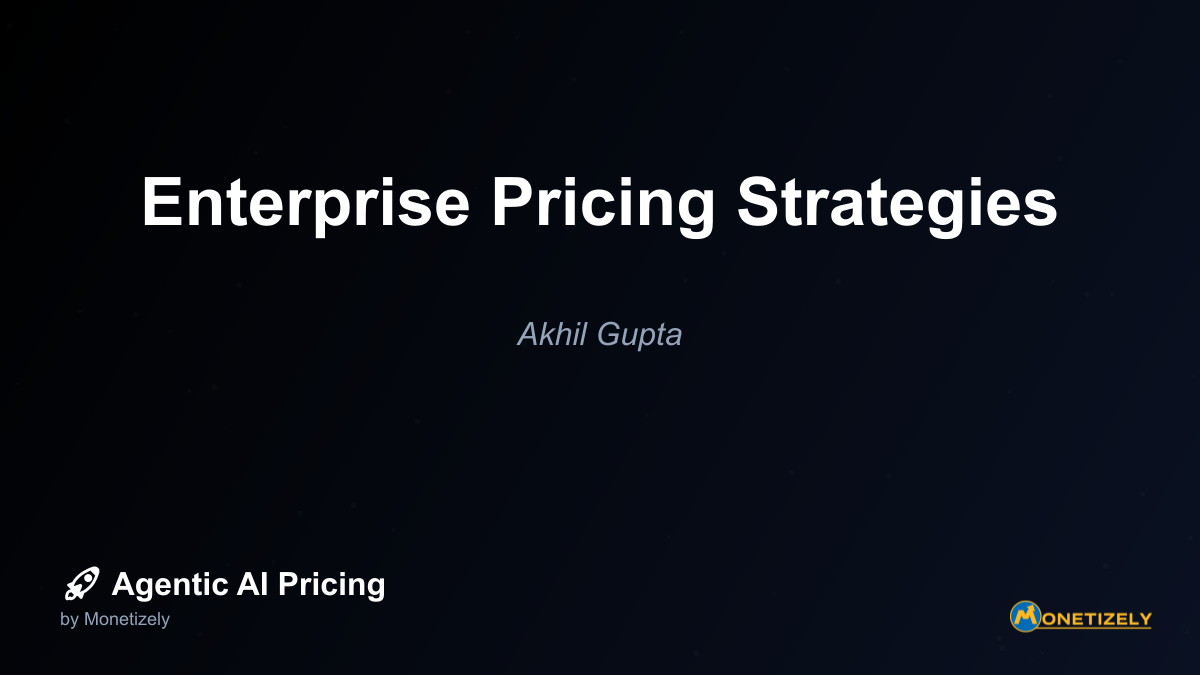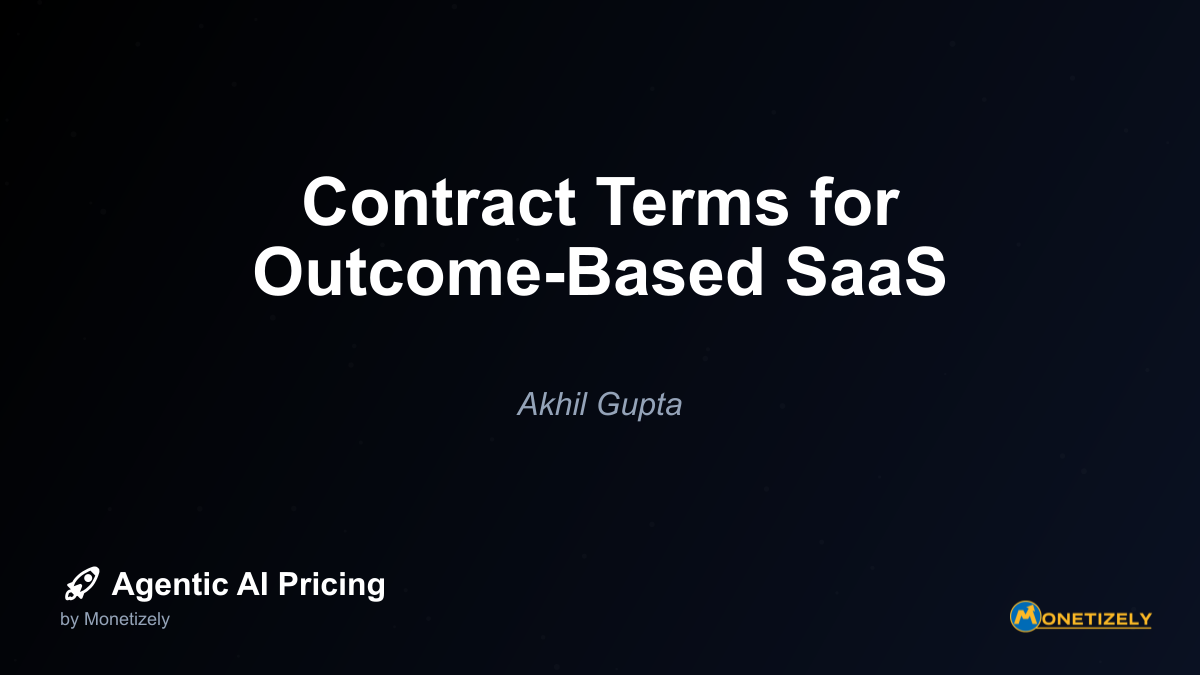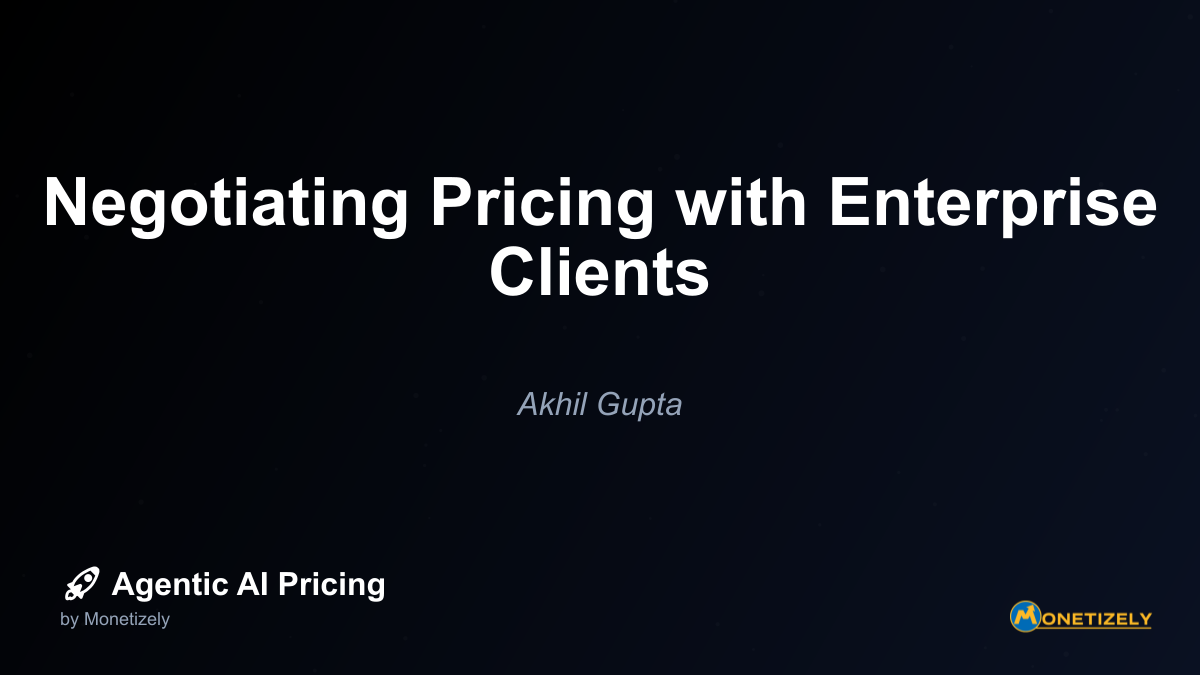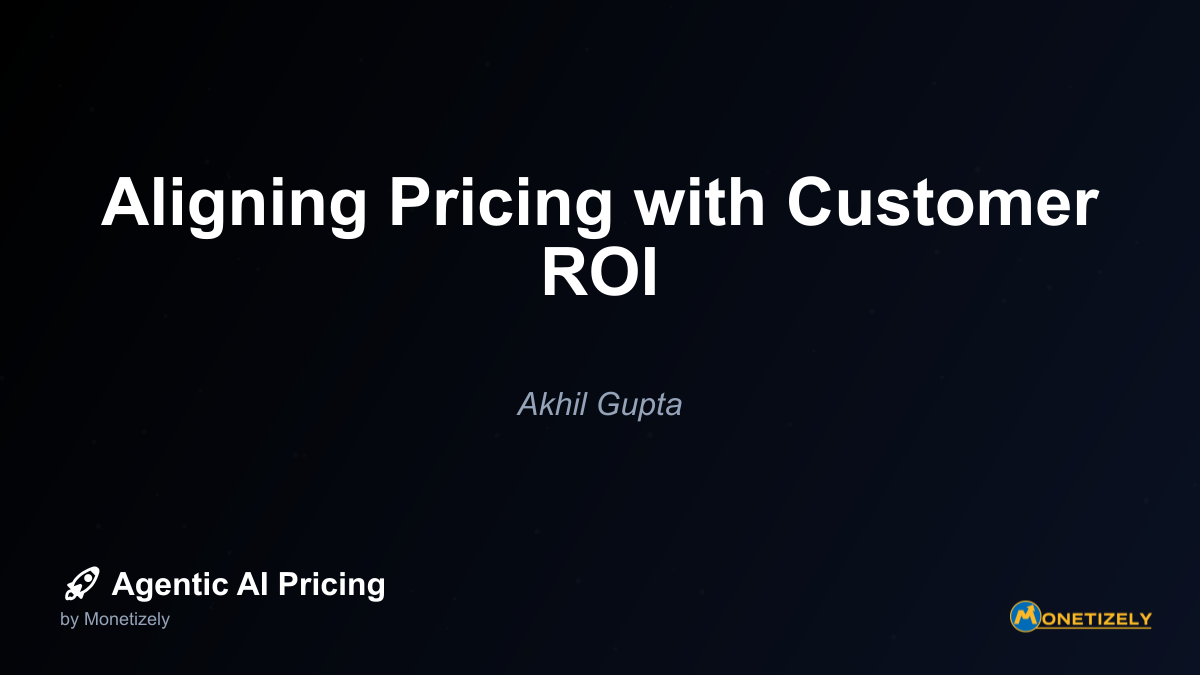· Akhil Gupta · Pricing Agentic SaaS Products · 12 min read
Enterprise Pricing Strategies
AI and SaaS Pricing Masterclass
Learn the art of strategic pricing directly from industry experts. Our comprehensive course provides frameworks and methodologies for optimizing your pricing strategy in the evolving AI landscape. Earn a professional certification that can be imported directly to your LinkedIn profile.

Now I’ll create a comprehensive blog post on enterprise pricing strategies for agentic AI products.
The evolution of artificial intelligence has entered a new phase with the emergence of agentic AI—autonomous systems capable of performing complex tasks with minimal human intervention. For enterprises looking to leverage these powerful tools, structuring appropriate pricing models presents unique challenges that extend far beyond traditional software licensing. The autonomous nature of AI agents, their ability to scale across functions, and the complex value they deliver demand sophisticated pricing approaches that align with business outcomes while managing implementation complexity.
Understanding the Enterprise AI Agent Landscape
Enterprise adoption of agentic AI is accelerating rapidly, with market forecasts projecting explosive growth from approximately $5.25 billion in 2024 to over $52 billion by 2030—a compound annual growth rate exceeding 46%. This surge reflects the transition from simple automation tools to truly autonomous agents capable of complex decision-making across enterprise functions.
The unique characteristics of agentic AI create distinct pricing challenges:
Value Measurement: Unlike traditional software that provides fixed functionality, AI agents deliver variable, often unpredictable value through autonomous decision-making.
Consumption Variability: Usage patterns for AI agents can fluctuate dramatically based on business needs, making traditional seat-based licensing problematic.
Implementation Complexity: Enterprise AI deployments require significant customization, integration, and training efforts that must be factored into pricing.
Outcome Alignment: Enterprises expect pricing to reflect actual business outcomes achieved rather than simply access to technology.
As CIOs report approximately 75% annual growth in AI budgets, understanding effective pricing strategies becomes crucial for both vendors and buyers in the enterprise market.
Dominant Enterprise AI Agent Pricing Models
The enterprise market has moved decisively away from traditional seat-based licensing toward more dynamic models that better reflect how AI agents deliver value. The most prevalent pricing approaches include:
1. Usage-Based and Consumption Models
Usage-based pricing has emerged as a dominant model for enterprise AI agents, with approximately 56% of SaaS companies now incorporating consumption elements into their pricing structures. This approach charges based on actual utilization metrics such as:
- API calls or transactions processed
- Computational resources consumed
- Data volume processed or stored
- Time spent on tasks
Companies like Cognition AI exemplify this approach with their “Agent compute units” priced at $2.25 per unit, abstracting complex computational resources into a measurable billing metric that customers can understand and budget for.
Advantages: This model creates natural alignment between costs and value received, scales with customer growth, and provides transparency into actual usage.
Challenges: Usage-based models can create budget unpredictability for enterprises, especially when consumption spikes occur. This often leads to the implementation of usage caps or spending thresholds to manage cost exposure.
2. Outcome-Based Pricing
Perhaps the most sophisticated approach, outcome-based pricing ties costs directly to measurable business results achieved by the AI agent. This model has gained significant traction, with 78% of firms now basing pricing primarily on customer-perceived value.
Sierra’s approach exemplifies this model—they charge only when AI agents successfully resolve customer inquiries, creating perfect alignment between pricing and the customer’s goal of efficient support resolution.
Advantages: Creates perfect alignment between vendor and customer incentives, focusing on value delivered rather than technology consumed.
Challenges: Requires clear definition of success metrics, reliable measurement mechanisms, and agreement on attribution of outcomes.
3. Hybrid Models
Most enterprise AI pricing now incorporates hybrid approaches that combine elements of different models to balance predictability with value alignment. A common structure includes:
- Base subscription fee covering core functionality
- Usage-based components for variable consumption
- Outcome-based incentives or bonuses tied to specific results
Salesforce’s Agentforce offers a hybrid model with per-conversation pricing at $2 per conversation, moving away from traditional seat licensing while maintaining predictability through conversation-based metrics.
Advantages: Provides budget predictability while maintaining incentives for value delivery, allowing for gradual transition from traditional models.
Challenges: Can create complex pricing structures that are difficult to communicate and understand.
4. FTE Replacement Model
An emerging approach treats AI agents as fractional replacements for human employees, with pricing structured as a percentage of the fully-loaded cost of the positions being augmented or replaced. This model is particularly effective for agents that perform tasks previously handled by knowledge workers.
Advantages: Creates intuitive value comparison against existing labor costs, making ROI calculations straightforward.
Challenges: May create organizational resistance if positioned as replacement rather than augmentation of human workers.
Enterprise AI Agent Contract Structuring
Beyond the basic pricing model, enterprise AI agent deals require sophisticated contract structures that address the unique characteristics of autonomous systems. Key elements include:
Service Level Agreements (SLAs)
Enterprise AI agent contracts require detailed SLAs that go beyond traditional uptime metrics to include:
- Performance benchmarks: Response time, accuracy rates, and throughput metrics
- Availability guarantees: System uptime with penalties for failures
- Support tiers: Response times for different severity levels
- Maintenance windows: Scheduled downtime for updates and training
- Escalation procedures: Clear paths for addressing performance issues
SLAs should incorporate remediation processes when autonomous agents fail to meet performance thresholds, with clear accountability for corrective actions.
Data Usage Rights and Ownership
AI agents operate on enterprise data, creating complex questions around data ownership and usage rights that must be explicitly addressed in contracts:
- Input data ownership: Typically remains with the enterprise customer
- Training data rights: Specify whether vendor can use customer data to improve models
- Model ownership: Clarify ownership of AI models trained on enterprise data
- Output ownership: Establish clear ownership of agent-generated content and decisions
- Data return/destruction: Specify processes for data handling upon contract termination
These provisions are particularly critical for enterprises in regulated industries where data governance requirements are stringent.
Customization and Integration Costs
Enterprise AI agent deployments invariably require customization to integrate with existing systems and workflows. Contracts should clearly delineate:
- Initial implementation costs: Setup, configuration, and training expenses
- Integration fees: Connecting to enterprise systems like ERP, CRM, etc.
- Customization charges: Adapting agents to specific enterprise requirements
- Training costs: Initial and ongoing model training expenses
- Change request pricing: How modifications are priced after initial deployment
JPMorgan’s COIN AI system for contract review demonstrates the importance of this approach, as its value derived from deep integration with existing legal workflows and document systems.
Legal and Compliance Considerations
The autonomous nature of AI agents creates unique legal considerations that must be addressed contractually:
- Liability provisions: Responsibility for agent actions and decisions
- Regulatory compliance: Adherence to industry-specific regulations
- Audit rights: Enterprise access to review agent operations
- Explainability requirements: Ability to understand agent decision-making
- Human oversight provisions: Mechanisms for human review of agent actions
These considerations become particularly important for AI agents operating in regulated environments or making high-consequence decisions.
Enterprise vs. SMB AI Agent Pricing: Key Differences
Enterprise AI agent pricing differs substantially from SMB approaches across multiple dimensions:
| Aspect | Enterprise AI Agents | SMB AI Agents |
|---|---|---|
| Budget Expectations | Larger budgets (often millions+); AI represents 8-12% of IT budget | Smaller budgets with tight cost controls; AI is smaller fraction of IT spend |
| Deal Size & Structure | Six to seven-figure contracts; highly customized with volume discounts and enterprise SLAs | Smaller, simpler pricing tiers with transparent feature differentiation |
| Sales & Negotiation | Complex multi-stakeholder decisions; 6-18 month sales cycles; focus on customization and compliance | Shorter sales cycle (1-3 months); limited negotiation; standardized terms |
| Value Proposition | ROI, risk mitigation, security compliance, integration with legacy systems | Ease of use, out-of-box functionality, quick deployment, cost-effectiveness |
| Governance & Risk | Premium pricing for enhanced governance, auditability, compliance | Simplified controls appropriate for smaller teams and lower regulatory risk |
These differences highlight why enterprise AI agent pricing requires a fundamentally different approach from SMB offerings, with greater emphasis on customization, integration, and value-based pricing models.
Negotiation Strategies for Enterprise AI Agent Deals
Enterprise AI agent deals involve complex negotiations that balance value, risk, and cost considerations. Effective negotiation strategies include:
1. Value-Based Negotiation Approach
The most effective enterprise AI agent negotiations center on business value rather than technology costs. This approach involves:
- ROI modeling: Quantifying expected business outcomes in financial terms
- Value benchmarking: Comparing potential results against industry standards
- Pilot programs: Testing value delivery at smaller scale before full deployment
- Success metrics: Establishing clear KPIs for measuring value realization
Shell’s equipment failure prediction AI implementation exemplifies this approach, with negotiations focused on the operational efficiency gains and safety improvements from predicting and preventing failures across 10,000+ assets.
2. Risk Mitigation Strategies
Enterprise negotiations must address the unique risks of autonomous systems:
- Phased implementation: Starting with low-risk use cases before expanding
- Performance guarantees: Contractual assurances of minimum acceptable results
- Exit clauses: Clear terms for termination if value isn’t realized
- Escrow arrangements: Code or model access in case of vendor issues
- Liability caps: Reasonable limitations on damages from agent errors
These provisions help enterprises manage the inherent uncertainties of deploying autonomous systems while providing vendors with reasonable protection.
3. Pricing Flexibility and Scalability
Successful enterprise negotiations establish flexible frameworks that accommodate growth:
- Volume discounts: Reduced rates as usage increases
- Expansion rights: Favorable terms for adding capabilities or use cases
- Price protection: Caps on future price increases
- Renewal terms: Clear conditions for contract extensions
- Technology refresh: Access to new capabilities as they emerge
Citadel Securities’ implementation of Google Cloud TPUs for AI workloads demonstrates this approach, with contracts structured to optimize both performance and cost efficiency as computational needs scale.
Measuring ROI and Value from Enterprise AI Agents
Establishing clear ROI measurement frameworks is essential for justifying enterprise AI agent investments and supporting value-based pricing models. Effective approaches include:
1. Quantitative Metrics
Key quantitative measures for enterprise AI agent value include:
- Labor efficiency: Reduced hours or headcount for specific functions
- Process acceleration: Decreased cycle times for key workflows
- Error reduction: Lower defect or exception rates
- Cost avoidance: Prevented expenses through improved decision-making
- Revenue enhancement: Increased sales or margins from AI-driven insights
Many large organizations project ROI exceeding 100% from agentic AI implementations, with U.S. companies averaging 192% returns according to recent research.
2. Qualitative Value Indicators
Beyond direct financial metrics, enterprises should track qualitative benefits:
- Employee satisfaction: Improved experience through elimination of routine tasks
- Customer experience: Enhanced service levels and response times
- Decision quality: Better, more consistent choices across the organization
- Risk reduction: Fewer compliance issues or operational incidents
- Innovation capacity: Increased bandwidth for creative work
These qualitative factors often translate into long-term competitive advantages that exceed immediate financial returns.
3. Continuous Value Assessment
Enterprise AI agent value should be measured continuously rather than as a one-time calculation:
- Value tracking dashboards: Real-time visibility into key metrics
- Regular ROI reviews: Scheduled reassessments of financial returns
- Comparative benchmarking: Performance versus industry standards
- Feedback mechanisms: Structured input from users and stakeholders
- Iterative optimization: Ongoing refinement based on performance data
This approach ensures that AI agents continue delivering value throughout their lifecycle while providing data to support renewal negotiations.
Future Trends in Enterprise AI Agent Pricing
As the enterprise AI agent market matures, several pricing trends are emerging that will shape strategies over the next 2-3 years:
1. Increased Autonomy Premium
As AI agents become more autonomous and capable of complex decision-making without human intervention, pricing models will increasingly incorporate premiums for advanced autonomy features. This trend reflects the higher value delivered by truly independent agents versus those requiring significant human oversight.
2. Multi-Agent Ecosystem Pricing
Enterprise deployments are evolving toward ecosystems of specialized AI agents working in concert. Pricing models will adapt to this reality with:
- Agent orchestration fees: Charges for coordinating multiple specialized agents
- Agent marketplace models: Subscription access to libraries of purpose-built agents
- Cross-agent integration pricing: Fees for enabling seamless agent collaboration
This approach acknowledges that enterprise value often comes from agent interaction rather than isolated capabilities.
3. Regulatory and Compliance-Driven Pricing
As AI regulation increases globally, enterprise pricing will incorporate compliance-related elements:
- Transparency premiums: Higher fees for fully explainable AI systems
- Compliance certification costs: Charges for maintaining regulatory adherence
- Audit-ready features: Premium pricing for systems with robust audit capabilities
- Ethical AI guarantees: Value-based pricing for responsible AI implementations
These elements will become particularly important in highly regulated industries like healthcare, finance, and government.
4. Dynamic, AI-Driven Pricing
Perhaps most intriguingly, AI systems themselves will increasingly determine optimal pricing through:
- Real-time value assessment: Continuous calculation of delivered business value
- Predictive pricing models: AI-generated forecasts of future value delivery
- Automated price optimization: Dynamic adjustment based on usage patterns
- Value-capture algorithms: Systems that identify and monetize previously hidden value
This approach represents the ultimate alignment between AI capabilities and pricing models, with intelligent systems determining their own economic value.
Implementing an Enterprise AI Agent Pricing Strategy
For organizations deploying AI agents or vendors serving the enterprise market, implementing effective pricing strategies requires a structured approach:
1. Value Discovery Process
Begin with a comprehensive assessment of potential value:
- Stakeholder interviews: Understand value perceptions across the organization
- Process analysis: Identify efficiency and effectiveness improvement opportunities
- Competitive benchmarking: Compare potential outcomes against industry standards
- Financial modeling: Quantify expected returns from various implementation scenarios
This discovery process establishes the foundation for value-based pricing discussions.
2. Pricing Model Selection
Choose the appropriate pricing model based on organizational readiness:
- Traditional enterprises: Start with hybrid models that include familiar subscription elements
- Digital natives: Consider pure consumption or outcome-based models
- Regulated industries: Incorporate compliance and governance premiums
- Cost-sensitive sectors: Implement caps and thresholds to ensure predictability
The selected model should align with both organizational culture and financial objectives.
3. Contract Structure Development
Create contract templates that address the unique aspects of AI agents:
- SLA frameworks: Define performance metrics and remediation processes
- Data rights provisions: Clarify ownership and usage permissions
- Integration specifications: Detail connection points with existing systems
- Governance requirements: Establish oversight and control mechanisms
- Scalability terms: Define parameters for growth and expansion
These templates provide the foundation for efficient negotiation and implementation.
4. Pilot and Refinement
Test pricing models through limited deployments:
- Controlled pilots: Implement initial use cases with carefully tracked metrics
- Pricing experimentation: Test different models with selected customers
- Feedback collection: Gather input on perceived value versus cost
- Model refinement: Adjust approaches based on real-world performance
This iterative approach reduces risk while optimizing pricing structures.
Case Studies: Successful Enterprise AI Agent Pricing
Examining successful implementations provides valuable insights into effective enterprise AI agent pricing strategies:
Case Study 1: JPMorgan COIN AI System
JPMorgan’s COIN AI system for contract review demonstrates the power of outcome-based pricing aligned with measurable business results:
- Implementation: AI system for reviewing commercial loan agreements
- Pricing approach: Based on labor hours saved and error reduction
- Results: Reduced manual review time from 360,000 hours to minutes
- ROI calculation: Clear financial return based on lawyer time reallocation
- Key success factor: Direct alignment between costs and quantifiable outcomes
Case Study 2: Salesforce Agentforce
Salesforce’s approach to pricing its Agentforce AI capabilities illustrates the effectiveness of per-conversation pricing:
- Implementation: AI agents for customer support automation
- Pricing approach: $2 per conversation, moving away from seat licensing
- Results: Simplified pricing aligned with actual usage
- ROI calculation: Based on reduced support costs and improved resolution rates
- Key success factor: Transparent connection between costs and support metrics
Case Study 3: Sierra’s Resolution-Based Model
Sierra’s innovative pricing approach demonstrates pure outcome-based pricing:
- Implementation: AI support agents for customer inquiries
- Pricing approach: Charges only when AI successfully resolves customer issues
- Results: Perfect alignment with customer goals of efficient support
- ROI calculation: Direct correlation between spending and successful outcomes
- Key success factor: Elimination of payment for unsuccessful AI interventions
These case studies highlight the importance of aligning pricing with measurable business outcomes rather than technical capabilities or resource consumption.
Challenges and Pitfalls in Enterprise AI Agent Pricing
Despite the promising models emerging, several challenges remain in enterprise AI agent pricing:
1. Value Attribution Complexity
Determining which outcomes are directly attributable to AI agents versus other factors remains difficult, particularly in complex enterprise environments where multiple systems and human actors interact. This challenge complicates outcome-based pricing models and ROI calculations.
2. Consumption Predictability
Usage-based models can create budget uncertainty when consumption patterns
Co-Founder & COO
Akhil is an Engineering leader with over 16+ years of experience in building, managing and scaling web-scale, high throughput enterprise applications and teams. He has worked with and led technology teams at FabAlley, BuildSupply and Healthians. He is a graduate from Delhi College of Engineering and UC Berkeley certified CTO.
Pricing Strategy Audit
Let our experts analyze your current pricing strategy and identify opportunities for improvement. Our data-driven assessment will help you unlock untapped revenue potential and optimize your AI pricing approach.




